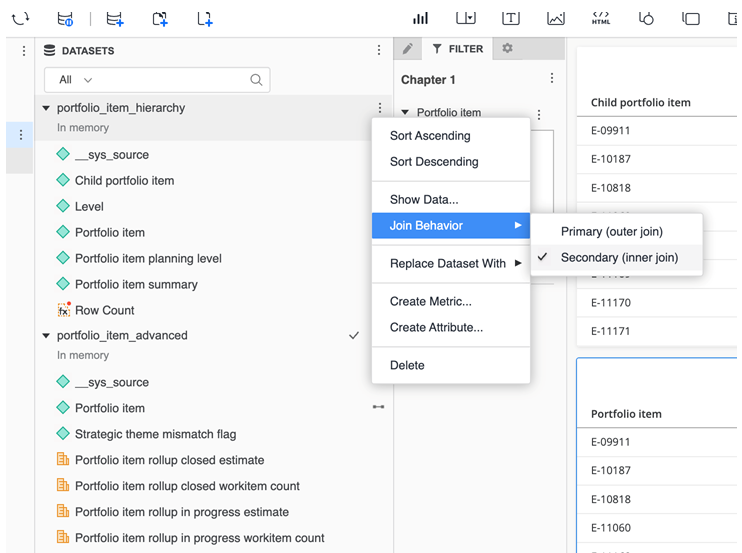Portfolio Item Hierarchy
The portfolio item hierarchy dataset structures data to represent various levels within an organization’s portfolio. It categorizes items into programs, projects, and tasks, facilitating efficient management and tracking of activities. This dataset provides a comprehensive overview of the organization’s portfolio, supporting strategic decision-making and operational efficiency.
You can use this dataset to obtain metrics that consider all work items connected to the selected portfolio item and its child portfolio items.
Example: By combining the portfolio item hierarchy (child portfolio item) and work item base (work item portfolio item) datasets, applying a filter on the portfolio item (portfolio item hierarchy) will roll up the metrics to the selected portfolio item and all its child portfolio items. The example roll ups are story points and cycle time. Since this includes all child portfolio items, regardless of the planning level, it will also account for out-of-context items.
The following are the components of this dataset:
| Attribute Name | Description |
|---|---|
| Child portfolio item | Name of the child portfolio item that is created under a parent portfolio item |
| Child portfolio item type | Type of a child portfolio item, such as sub-feature or new feature. |
| Portfolio item | Unique identifier for the portfolio item |
| Portfolio item planning level | Planning level of the portfolio item |
| Portfolio item planning level end date | The date when the portfolio item's assigned planning level is set to conclude or become inactive. |
| Portfolio item planning level start date | The date when the portfolio item's assigned planning level begins or becomes active. |
| Portfolio item summary | Summary of the portfolio item |
| Portfolio item type | Type of a portfolio item, such as defect, story, test set |
| Portfolio item URL | URL of the portfolio item |
| Level | Depth of hierarchy |
| Sys_source | Unique identifier for the source |
This dataset doesn’t have any metrics.
Blending of Hierarchical Datasets with Other Datasets
When blending a hierarchical dataset with another dataset using the child element of the hierarchy, there is a possibility that the child may not exist or be eligible in the secondary dataset. In this process, the planning level filter is applied to the parent of the hierarchical dataset, while the child is joined to the other dataset. However, the child dataset applies the planning level filter directly to the child element. This can result in the hierarchical dataset retrieving more child records than the child dataset, which may lead to null values for missing or ineligible records.
To resolve this issue, the join type for the hierarchical dataset should be adjusted from the default Outer Join to an Inner Join.
For example, when blending the Portfolio Item Hierarchy dataset with the Portfolio Item Advanced dataset to retrieve the Strategic Theme Mismatch Flag, NULL records may appear. This occurs because the number of child portfolio item records in the Portfolio Item Hierarchy is less than the number of portfolio items in the Portfolio Item Advanced dataset. This mismatch causes null records when trying to fetch the Strategic Theme Mismatch Flag for the child based on the parent portfolio item. To avoid this, after blending, the "Join Behavior" of the hierarchical dataset should be changed from "Primary (Outer Join)" to "Secondary (Inner Join)."
